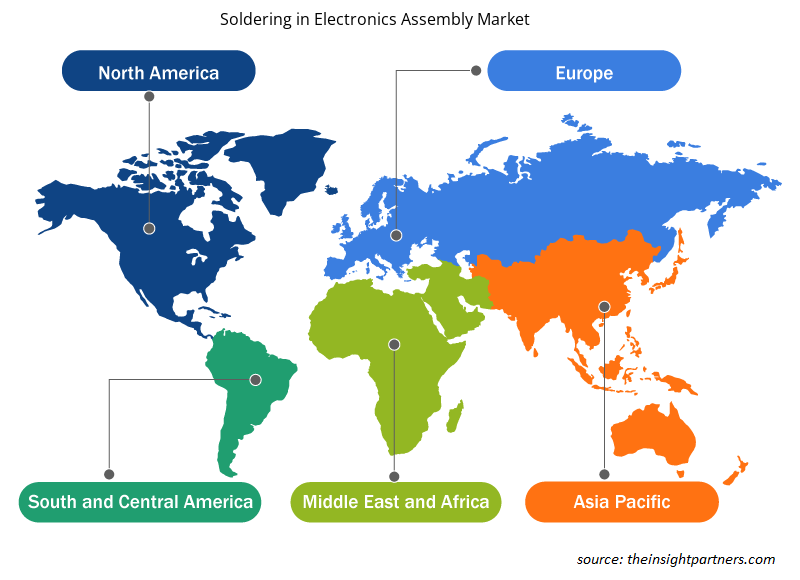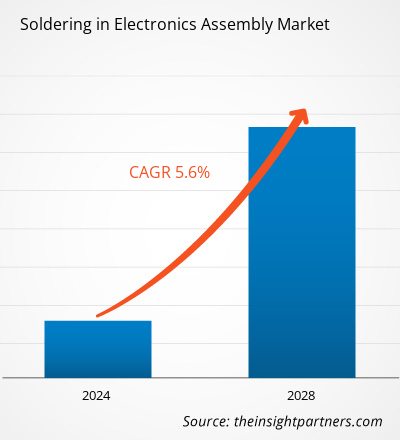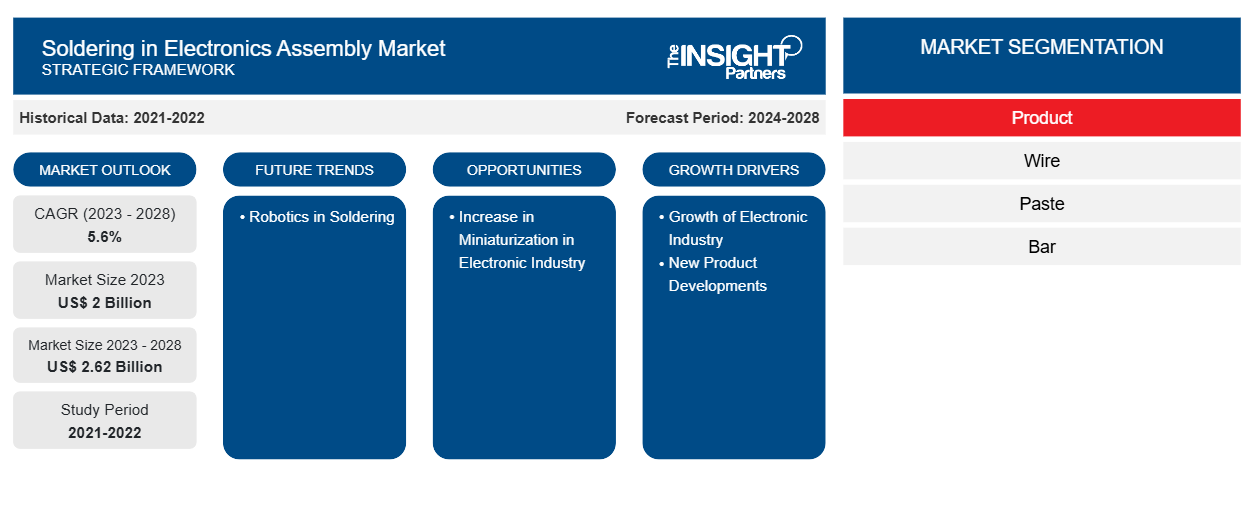[Forschungsbericht] Der Markt für Lötarbeiten in der Elektronikmontage soll von 2.001,96 Millionen US-Dollar im Jahr 2023 auf 2.624,71 Millionen US-Dollar im Jahr 2028 wachsen; von 2023 bis 2028 wird eine durchschnittliche jährliche Wachstumsrate (CAGR) von 5,6 % erwartet.
Die Miniaturisierung elektronischer Komponenten spielt in der Elektronikindustrie eine wichtige Rolle. Sie hilft, Platz zu sparen, sodass zusätzliche Teile oder Technologien integriert werden können, oder die Gesamtgröße von Unterhaltungselektronik, medizinischen Geräten, Autos und mehr kann reduziert werden. Die reduzierte Größe von Batterien beispielsweise trägt zur Miniaturisierung von Computern bei. Darüber hinaus hilft die Miniaturisierung, die Kosten des insgesamt verwendeten Materials zu senken. Für die Miniaturkomponenten wird weniger Material zum Löten verwendet, was dazu beiträgt, die Materialkosten im Vergleich zu Komponenten oder Geräten normaler Größe zu senken. Solche Vorteile der Miniaturisierung treiben die Nachfrage nach dieser Technik auf dem Elektronikmarkt an. Darüber hinaus treibt die Nachfrage nach Lötpasten mit kleineren Metallpartikelgrößen für die Miniaturisierung das Wachstum des Lötens in der Elektronikmontage voran . Das in Frankreich ansässige Unternehmen INVENTEC bietet die Lötpasten Ecorel Free JP32 und Ecorel Free HT 235-16LVD an, die bei der Miniaturisierung für Anwendungen zur Herstellung von Elektronik mit ultrafeinen Abständen verwendet werden können. Aufgrund der wachsenden Nachfrage nach Miniaturisierung entwickelt das Unternehmen weitere Lötpastenprodukte. Daher ist zu erwarten, dass die zunehmende Miniaturisierung in der Elektronikindustrie Wachstumschancen für den Markt des Lötens in der Elektronikmontage bietet.
Löten im Markt für Elektronikmontage -
Passen Sie diesen Bericht Ihren Anforderungen an
Sie erhalten kostenlose Anpassungen an jedem Bericht, einschließlich Teilen dieses Berichts oder einer Analyse auf Länderebene, eines Excel-Datenpakets sowie tolle Angebote und Rabatte für Start-ups und Universitäten.
- Holen Sie sich die wichtigsten Markttrends aus diesem Bericht.Dieses KOSTENLOSE Beispiel umfasst eine Datenanalyse von Markttrends bis hin zu Schätzungen und Prognosen.
Auswirkungen der COVID-19-Pandemie auf das Löten in der Elektronikmontage
Die COVID-19-Pandemie verursachte Störungen in der Fertigungsindustrie und wirkte sich auf alle Prozesse aus, von der Lieferkette und dem Betrieb bis hin zu Investitionen, Krediten und langfristigen Strategien. Die Pandemie unterbrach den Teileexport und die Massenproduktion. Laut der Konferenz der Vereinten Nationen für Handel und Entwicklung (UNCTAD) brachen die weltweiten ausländischen Direktinvestitionen (FDI) im Jahr 2020 im Vergleich zu 2019 um 42 % ein. Die Preise für Zinn und Blei stiegen während der Pandemie sprunghaft an, was zu einem Rückgang der Nachfrage nach Lötprodukten führte. Andererseits stieg aufgrund der Pandemie die Nachfrage nach medizinischen Geräten wie Herzschrittmachern, Defibrillatoren, Neurostimulatoren, Ultraschallgeräten und Infusionspumpen. Darüber hinaus sind die Homeoffice-Kultur und der Online-Unterricht einige Faktoren, die die Nachfrage nach Laptops und Mobiltelefonen während der Pandemie ankurbelten. So verzeichnete Lenovo beispielsweise im zweiten Quartal 2020 aufgrund der Einführung des Homeoffice-Modells erhebliche Finanzergebnisse; sie stiegen im Jahresvergleich um 7 %. Daher haben die Auswirkungen von COVID zu negativen Störungen im Lötgeschäft auf dem Markt für die Elektronikmontage geführt.
Markteinblicke – Löten im Markt für Elektronikmontage
Im Laufe der Jahre haben China und Indien ihre Investitionen zur Entwicklung ihres Fertigungssektors erheblich erhöht. Diese Länder haben auch Initiativen wie „Made in China 2025“ und „Make in India“ gestartet, um die lokale Fertigung zu fördern. Darüber hinaus treibt die Verfügbarkeit billiger Arbeitskräfte die rasante Entwicklung des Fertigungssektors in Indien und China voran und macht diese Länder zu Zentren für die Herstellung von Unterhaltungselektronik und elektronischen Komponenten wie Leiterplatten, Sensoren, Festplatten und Motherboards . Darüber hinaus wird erwartet, dass die steigenden Investitionen globaler Unternehmen in Branchen wie der Herstellung medizinischer Geräte, der Elektronik und der Automobilindustrie zum Aufbau ihrer Produktionsanlagen in der gesamten Region in den kommenden Jahren weiter zum Wachstum des Marktes für Löten in der Elektronikmontage in der Asien-Pazifik-Region beitragen werden.
Produktinformationen
Basierend auf dem Produkt ist der Markt für Löten in der Elektronikmontage in Drähte, Pasten, Flussmittel, Stangen und andere unterteilt. Das Drahtsegment hatte 2022 den größten Marktanteil. Lötdrähte sind in verschiedenen Stärken, Typen und Lötverfahren erhältlich. Manuelles Löten, Laserlöten und automatisiertes Eisenlöten gehören zu den am häufigsten verwendeten Lötverfahren. Basierend auf der Zusammensetzung sind bleihaltige und bleifreie Lötdrähte auf dem Markt erhältlich. Bleifreie Lötdrähte werden in den meisten Anwendungen verwendet, um die RoHS-Richtlinie einzuhalten. Der bleifreie Lötdraht hat starke Benetzungseigenschaften, da er 3 % Silber enthält. Der silberfreie Lötdraht spart die Betriebskosten der Elektronikmontage.
Der flussmittelgefüllte Lötdraht wird in verschiedenen Prozessen verwendet, darunter automatisiertes und robotergestütztes Löten. Der flussmittelgefüllte Draht CW-818 von Indium Corporation bietet eine schnelle Benetzungsgeschwindigkeit, um die Zykluszeiten bei manuellen und robotergestützten Lötprozessen zu minimieren; dieser Draht weist Hitzebeständigkeit und geringe Spritzereigenschaften des Kernflussmittels auf und bietet dadurch bessere Baugruppen für manuelle und robotergestützte Lötprozesse.
Regionale Einblicke in den Markt für Löten in der Elektronikmontage
Die regionalen Trends und Faktoren, die den Markt für Löten in der Elektronikmontage während des gesamten Prognosezeitraums beeinflussen, wurden von den Analysten von Insight Partners ausführlich erläutert. In diesem Abschnitt werden auch die Marktsegmente und die Geografie für Löten in der Elektronikmontage in Nordamerika, Europa, im asiatisch-pazifischen Raum, im Nahen Osten und Afrika sowie in Süd- und Mittelamerika erörtert.

- Erhalten Sie regionale Daten zum Löten in der Elektronikmontage
Umfang des Marktberichts zum Löten in der Elektronikmontage
| Berichtsattribut | Details |
|---|---|
| Marktgröße im Jahr 2023 | 2 Milliarden US-Dollar |
| Marktgröße bis 2028 | 2,62 Milliarden US-Dollar |
| Globale CAGR (2023 - 2028) | 5,6 % |
| Historische Daten | 2021-2022 |
| Prognosezeitraum | 2024–2028 |
| Abgedeckte Segmente | Nach Produkt
|
| Abgedeckte Regionen und Länder | Nordamerika
|
| Marktführer und wichtige Unternehmensprofile |
|
Dichte der Marktteilnehmer für Löten in der Elektronikmontage: Auswirkungen auf die Geschäftsdynamik verstehen
Der Markt für Löten in der Elektronikmontage wächst rasant, angetrieben durch die steigende Endverbrauchernachfrage aufgrund von Faktoren wie sich entwickelnden Verbraucherpräferenzen, technologischen Fortschritten und einem größeren Bewusstsein für die Vorteile des Produkts. Mit steigender Nachfrage erweitern Unternehmen ihr Angebot, entwickeln Innovationen, um die Bedürfnisse der Verbraucher zu erfüllen, und nutzen neue Trends, was das Marktwachstum weiter ankurbelt.
Die Marktteilnehmerdichte bezieht sich auf die Verteilung von Firmen oder Unternehmen, die in einem bestimmten Markt oder einer bestimmten Branche tätig sind. Sie gibt an, wie viele Wettbewerber (Marktteilnehmer) in einem bestimmten Marktraum im Verhältnis zu seiner Größe oder seinem gesamten Marktwert präsent sind.
Die wichtigsten Unternehmen auf dem Markt für Löten in der Elektronikmontage sind:
- Lucas-Milhaupt, Inc
- GENMA Europe GmbH
- S-Bond Technologie
- Fusion Incorporated
- Indium Corporation
Haftungsausschluss : Die oben aufgeführten Unternehmen sind nicht in einer bestimmten Reihenfolge aufgeführt.

- Überblick über die wichtigsten Akteure auf dem Markt für Löten in der Elektronikmontage
Der globale Markt für Löten in der Elektronikmontage ist nach Produkt segmentiert. Basierend auf dem Produkt ist der Markt in Draht, Paste, Flussmittel, Stangen und andere segmentiert. Nach Regionen ist der Markt für Löten in der Elektronikmontage in Nordamerika, Europa, Asien-Pazifik (APAC), Naher Osten und Afrika (MEA) und Südamerika (SAM) segmentiert.
GENMA Europe GmbH, Indium Corporation, Fusion Incorporated, AIM Metals & Alloys LP und MacDermid Alpha Electronics Solutions gehören zu den wichtigsten weltweit tätigen Akteuren auf dem Markt für Löttechnik in der Elektronikmontage.
Die Akteure auf dem Markt für Lötarbeiten in der Elektronikmontage konzentrieren sich hauptsächlich auf die Entwicklung fortschrittlicher und effizienter Produkte.
- Im Jahr 2021 gaben der Elektronikfertigungsdienstleister „Foxconn Technology Group“ und das Halbleiterunternehmen „MediaTek“ eine Zusammenarbeit zur Entwicklung neuer 5G-Lösungen für Smart Manufacturing und Industrie 4.0-Anwendungen bekannt. Diese Zusammenarbeit könnte zu neuen Fortschritten in der Lötelektronikindustrie führen.
- Im Jahr 2020 ging der Lötgerätehersteller „Metcal“ eine Partnerschaft mit dem Elektronikdistributor „Farnell“ ein, um sein Produktangebot zu erweitern und neue Kunden in Europa zu erreichen.
- Historische Analyse (2 Jahre), Basisjahr, Prognose (7 Jahre) mit CAGR
- PEST- und SWOT-Analyse
- Marktgröße Wert/Volumen – Global, Regional, Land
- Branchen- und Wettbewerbslandschaft
- Excel-Datensatz
Aktuelle Berichte
Erfahrungsberichte
Grund zum Kauf
- Fundierte Entscheidungsfindung
- Marktdynamik verstehen
- Wettbewerbsanalyse
- Kundeneinblicke
- Marktprognosen
- Risikominimierung
- Strategische Planung
- Investitionsbegründung
- Identifizierung neuer Märkte
- Verbesserung von Marketingstrategien
- Steigerung der Betriebseffizienz
- Anpassung an regulatorische Trends























 Kostenlose Probe anfordern für - Löten im Markt für Elektronikmontage
Kostenlose Probe anfordern für - Löten im Markt für Elektronikmontage